Forty years ago tonight, The Sisters of Mercy played not one but two gigs back-to-back at iconic venues in the London borough of Camden, on a warm August evening which has gone down in Sisters folklore. Not only was it the only time that the band had played twice in one night, but if (as many fans believe) the listed gig at the legendary Manchester Hacienda the following month didn’t actually take place, then the second of the two gigs would have been second guitarist Ben Gunn’s last gig with the band in the UK.
Having recently played their first European shows at city centre outdoor festivals in Ancona
(31st July) and Brussels (5th August), The Sisters of Mercy were
booked to support avant-garde Dublin band Virgin Prunes at the Electric
Ballroom venue on the evening of Thursday 11th August 1983, with
tickets stating that the band would be on stage an hour after the doors opened
at 8 p.m.
The 1500
capacity venue is one of the few which the band played in their early days
which is still trading as a music venue under the same name today, and the combination of two of the most
talked-about bands of 1983 made the gig one of the stand-out events of what is
usually a very quiet month on the gig-going calendar. Virgin Prunes’s album If
I Die, I Die had found its way into many goth record collections thanks
partly to the band’s striking visual image and attractive record sleeves and on
the back of the single Baby Turns Blue, which remains an alternative
club floorfiller to this day, but also as a result of their unique live show,
which was exposed to the wider gig-going public thanks to this stunning performance on the sadly short-lived Channel 4 music show Whatever You Want.
As much a theatrical show as a gig, no verbal
description I could attempt here would do justice to the mesmerising spectacle to
which Virgin Prunes fans were treated, as far removed from The Sisters’ then straightforward high-octane
punk rock’n’roll show as could be imagined. Ironically, the Sisters’ own
enduring popularity ultimately owes much to a similarly atmospheric one-off show less than
two years later, the seminal Wake live video recorded at the Royal Albert
Hall, with the dry ice, hats and shadow-play lighting as much a part of the band’s
unique appeal at that time as the songs and the stark iconography of their own record sleeves.
Perhaps
aware that he may seem somewhat static and old school compared to the
headliners, contemporary reviews of the show refer to Eldritch upping the ante
in his own frontman role, with Sounds reviewer Robin Gibson, whilst
acknowledging the quality of his vocal performance, finding his stage persona “painfully
arrogant”, whilst Ulster fanzine Youth Anthem’s reviewer accuses the band (and presumably the singer in particular) of “the
worst case of heavy metal posing since Queen circa 1973” (which many would take
as a compliment!). Sisters fan and Heartland Forum user Bearskin also thought
that Eldritch was really trying to impress that evening: “I recall the Sisters
performance was very posturing - Von was in full strut mode, acting quite the
rock star. It was the first time I'd heard the Reptile House songs live.” However,
both written reviewers also acknowledge that despite their own misgivings about
the band’s music, the Sisters went down well with the crowd and were permitted
an encore, which was not often the case with support bands.
The Sounds review highlights the growing importance of Emma in the set, and the overall quality of the show can easily be heard in the three recordings of the gig which have survived, such as the version uploaded onto YouTube (and featured below), which begins with the now traditional crowd chant of “God Squad” over the introduction to usual set-opener in 1983, Kiss The Carpet, which receives a lively reception. After Eldritch’s cheery “’ello!” and the then-obligatory audience shouts for 1969, the singer announces Anaconda, in which the sound mix slowly begins to settle, although Gunn’s guitar still seems a little out of tune, as is the singer’s final line. The heat was clearly getting to the band, as Eldritch announces “You’ve never seen my abs [? arms? arse?] before, have you? Next time we come we’ll have some new songs and I’ll take my trousers off for you.” Before he can elaborate further, the opening riff of what turns into a rather grungy rendition of Alice can be heard. Again the audience requests start as soon as the cheering and applause die down at the end of the song. “No, we don’t play Jolene no more….Settle down,” replies Eldritch. A different member of the crowd then shouts for 1969. “We don’t that any more either, this is Burn,” intones Eldritch, introducing a particularly fine version of the Reptile House track, which is followed by an equally epic Emma, and a stately, if not funereal, Valentine, for which Eldritch for once manages the high note for the first, if not the second syllable of the final word. "This is called Heartland, and we think we're going to put it on a record...soon!" is how the singer introduces introduces the next track, which picks up the pace significantly, as does the following Adrenochrome, which is shambolic almost to the point of being unlistenable at times from a guitar perspective. After a lengthy interval to sort the guitar sound, the opening Doktor Avalanche salvo of Floorshow is greeted by cheers, although the drum machine's solo is extended on this occasion until the guitars are sufficiently (de-)tuned to join in. The band return for an encore, with Eldritch announcing "Hello, Wakefield", before the band launches into a typically unhinged incendiary Body Electric to close the show.
On a Virgin Prunes site, fan Shaun Morris commented “The only down point of the night was the venue which was underground and unbelievably hot. As we left the show sweat was running down the walls. God knows what it must have felt like onstage,” confirming the searing heat in the packed venue that others who attended have mentioned in their own accounts.
Having
finished the first show at the Electric Ballroom, The Sisters and their
entourage then headed the short distance down Camden High Street to the Camden
Palace, formerly a theatre, BBC radio studio and then in the 1970's a venue called the Music
Machine, which had a recently acquired reputation as the coolest club in London
after its makeover and rebranding in 1982 as the Camden Palace, when it became the centre of the New
Romantic scene fronted by Richard Strange.
The
Sisters’ gig was unadvertised, and most fans who had attended the show at the
Ballroom were unaware that it was taking place. Fan Robert L, who had hitched from the South-West of England, was one such fan who was sceptical about the reality of a second
show: “I was told about it and just thought 'sounds like bullshit, 2 gigs
in one night?'. Having hitchhiked from Plymouth I wasn't prepared to
travel across London on a rumour, and miss the Virgin Prunes... Someone also
told me the admission price, which was far more than I had in my pocket at the
time.”
However,
the inner circle of fans did know about the show, and in Mark Andrews' essential
biography of this period of the band, Paint My Name In Black And Gold,
Gary Marx is quoted as saying “It was a brilliant night because we hammered out
one set and then went on…marching down the road taking our audience with us, Pied-Piper-style, to the next gig.”
In the
book Rik B, a member of the band’s unofficial fan group The God Squad also
recalls that “there was no guest list at the Camden Palace, so the Sisters had twenty
or thirty ‘roadies’ that night…each person carrying a little bit [of equipment]
down the street” and into the venue!
The gig at Camden Palace started some time after midnight, and is therefore usually listed as 12th
August 1983, even though it was effectively on the same evening as the Ballroom gig. No
reviews were published of the Camden Palace show, and only one, probably
partial and muffled recording of the show has survived, and this extract, the
possible opener Emma, shows both band and audience in fine form, with the
latter joining in enthusiastically with Gary Marx’s impromptu rendition of Ghost
Riders In The Sky before it starts. The lack of soundcheck is evident in
the rather thin and reedy start, and the song gets off to a lacklustre
beginning, with first Adams false-starting, and then Marx playing a few bum
notes of his own in his opening riff. Even the perfectionist Eldritch is not
immune to the gaffes, missing his cue for his own second line. The band recovers manfully, and by the end the seven-minute song recovers its full dramatic
effect, although it does sound as if they are down to just the one guitar for
the last minute or so, possibly due to a technical mishap. There is
enthusiastic applause at the end however, which is repeated throughout the
show, which ends with a second cover version, Gimme Shelter, which had not been
played at the earlier show.
Heartland
Forum member Original GS who did both gigs, recalls that “it was a mad day all
round. A dozen of us in a van from Wakefield. We got home at about half past
eight the following morning!”. A perfect summation for a unique evening, the
last time that the band would play in the capital until the following May, by
which time major changes had occurred...
As for Camden
Palace, the venue was refurbished again in 2004 and renamed Koko, continuing to
trade successfully until it was badly damaged by fire in 2020, something of an
occupational hazard for venues which have hosted TSOM, but in this case the
story has had a happy ending, as recounted in this BBC news report.
My thanks for this post are largely due to Phil Verne, curator of The Sisters of Mercy 1980-1985 unofficial fan group on Facebook who gathered most of the artefacts used in this post, but also to Robin, Rik, Robert, Shaun, Mark, Gary and others who have contributed, wittingly or unwittingly, to this account.

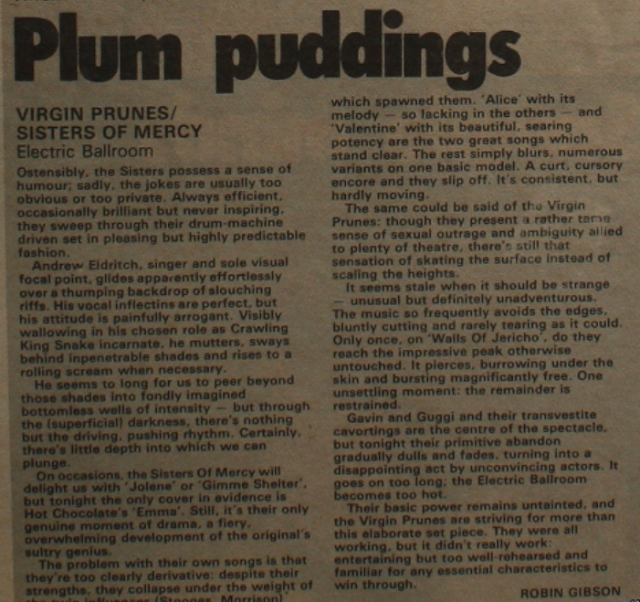

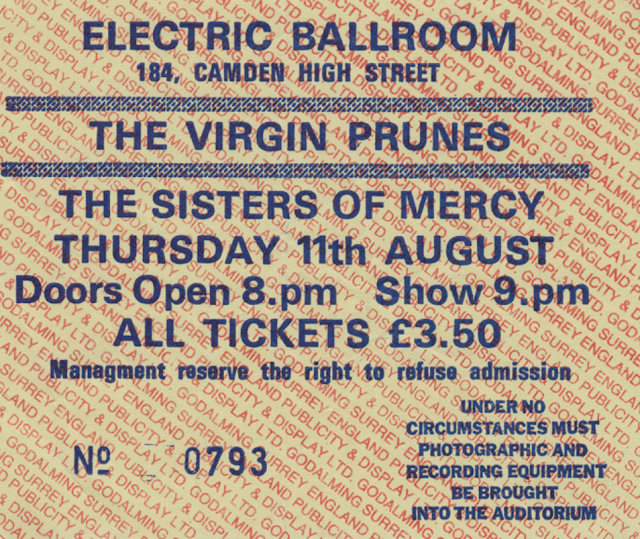
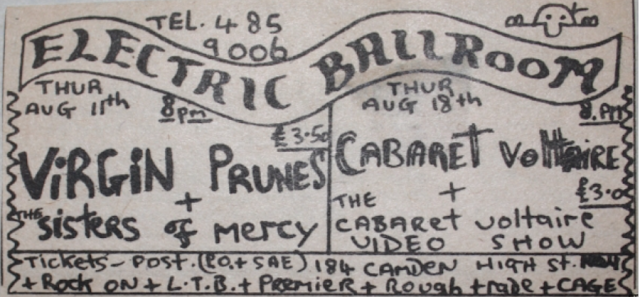









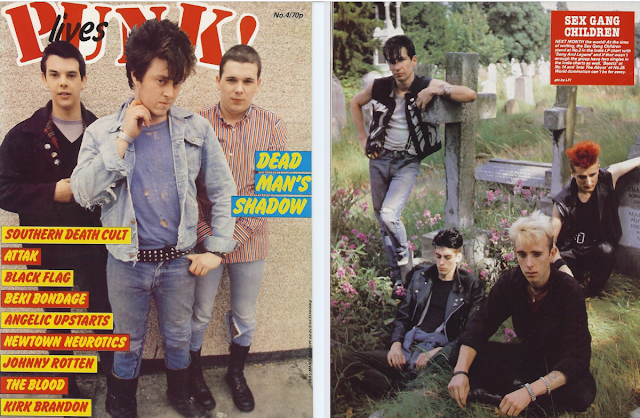

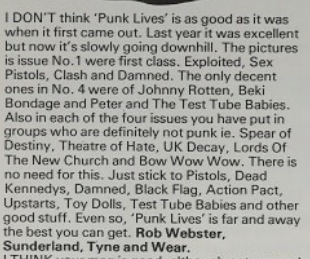






.jpg)